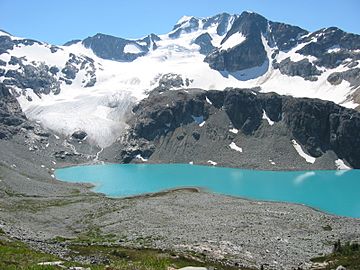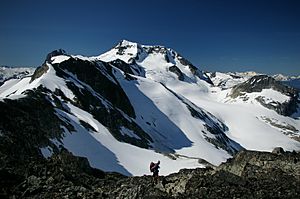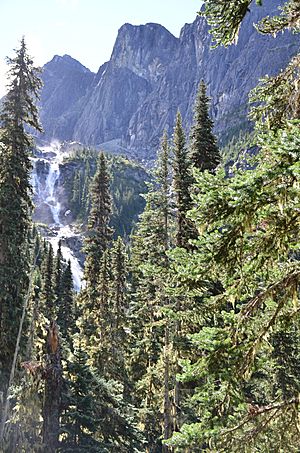Wedge Mountain facts for kids
Quick facts for kids Wedge Mountain |
|
|---|---|

Wedge Mountain from the north, with Wedgemount Lake in the foreground. The Wedgemount Lake hut and lake outlet are out of frame to the right.
|
|
| Highest point | |
| Elevation | 2,895 m (9,498 ft) |
| Prominence | 2,249 m (7,379 ft) |
| Listing |
|
| Geography | |
| Parent range | Garibaldi Ranges |
| Topo map | NTS 92J/02 |
| Climbing | |
| First ascent | 1923 N. Carter; C. Townsend |
| Easiest route | 3rd class snow climb with Glacier travel |
Wedge Mountain, which is about 2,895 m (9,498 ft) (or 9,498 feet) tall, is often called The Wedge. It is the highest peak in the Garibaldi Ranges and also in Garibaldi Provincial Park. This mountain is one of the closest tall peaks you can see from the Whistler Blackcomb Ski Area. It sits north of the valley that holds Billygoat Pass.
The mountain got its name in 1932 because it looks like a wedge. It is part of a group of peaks in the northern Garibaldi Ranges. Other famous mountains nearby include Mount Weart, known as the Armchair, and Mount Currie. Wedge Mountain is very prominent, meaning it stands out a lot from the land around it. This is because of the low point between the Green and Cheakamus Rivers near Alta Lake.
Exploring Wedge Mountain

To reach the area around Wedge Mountain, you can take a 6 km (3.7 mi) hike. This hike leads to a place called Wedgemount Lake, where there is a backcountry shelter and a camping area. It takes about three hours to hike to the lake from a parking lot near the Wedgemont rail stop.
Across Wedgemount Lake, you can see a glacier, and above that is the mountain's summit. The cabin at the north end of the lake is about 1,920 m (6,299 ft) high.
There are different ways to climb to the top of Wedge Mountain. One way is called the Northeast Arete, which is a sharp ridge that goes straight to the summit. This route needs special winter climbing gear. Another way is the South Face. This part looks like a very steep, rocky slope from the valley. To get to the South Face, climbers must go over the glacier. Most of Wedge Mountain is inside a provincial park, which means helicopters are not allowed to drop people off there. In the early 1970s, the glacier near Wedgemount Lake was much larger and reached into the lake.
Mountain Weather
Wedge Mountain has a marine west coast climate. This means it gets a lot of rain or snow. Most of the weather comes from the Pacific Ocean. As these weather systems move east, they hit the Coast Mountains. The mountains force the air upwards, which makes it cool down and drop its moisture as rain or snow. This is called Orographic lift. Because of this, the Coast Mountains get a lot of precipitation, especially snow in winter. The best time to climb Wedge Mountain is usually from July to September, when the weather is most favorable.



